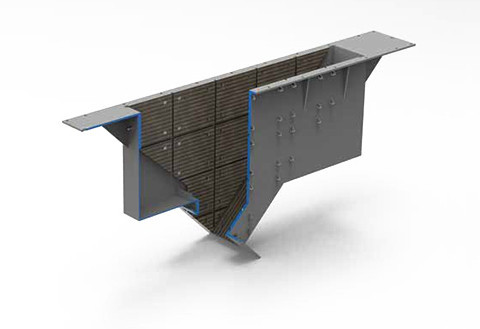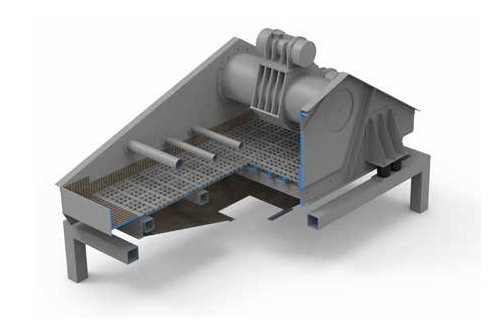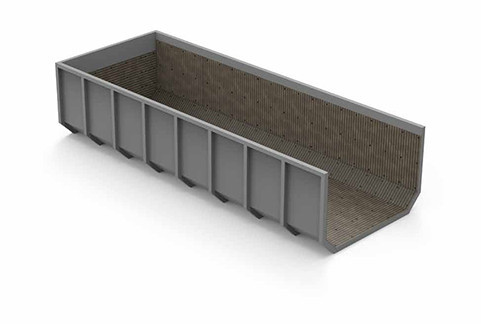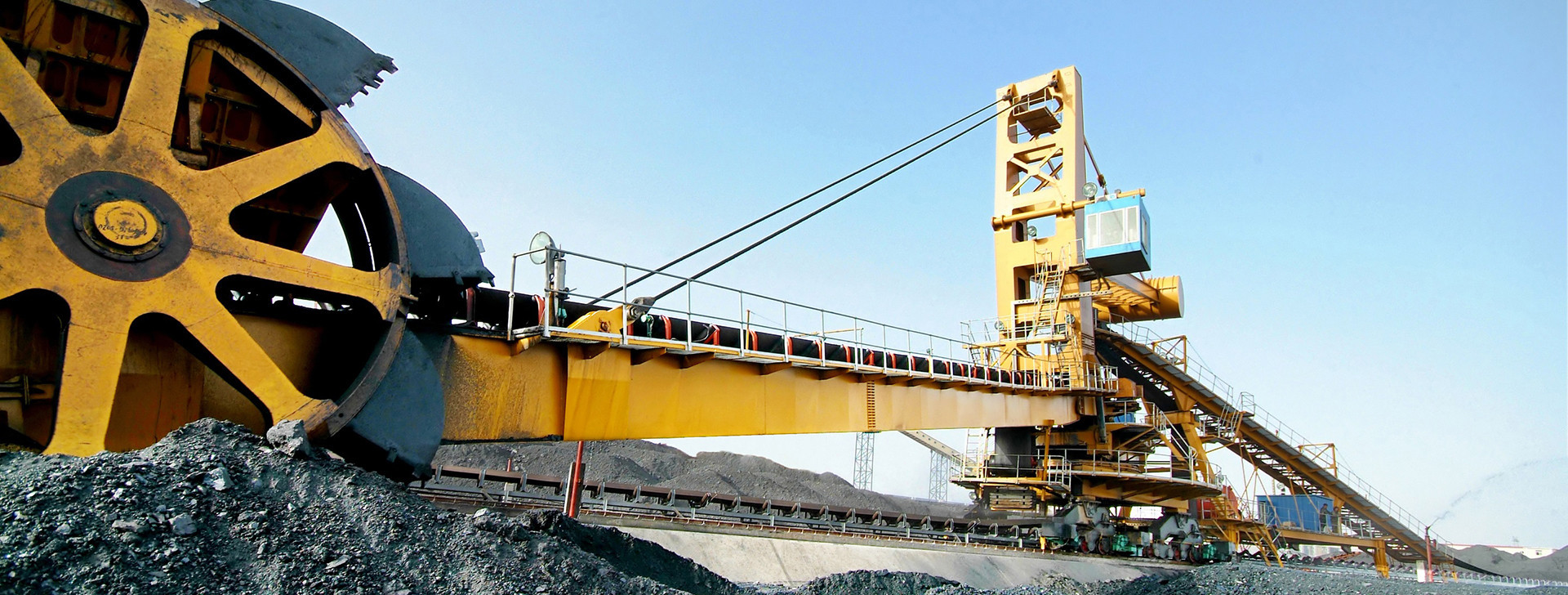Mining industry
When it comes to protection of industrial mining and processing equipment from abrasive wear, there are several effective solutions, including overlay welding technology, cast basalt and high-alumina ceramics. The use of each of the mentioned technologies has a number of features and advantages:
1. Overlay welding involves applying a wear-resistant layer to the surface of the equipment using welding methods. This layer usually consists of high strength alloys or carbides such as chromium carbide. The hard overlay provides superior abrasion and impact resistance, protecting the underlying hardware from wear and tear. In the mining industry, overlay welding is commonly used to protect equipment and components subject to high wear and abrasion, among which the main ones are:
- Buckets for mining excavators. These large buckets are used to extract and transport large quantities of material and are subject to significant wear and tear during operation.
- Dump truck bodies. Truck bodies are constantly exposed to abrasive materials such as rock and ore, which can cause rapid wear of the metal surface.
- Crusher hammers. These parts of the crushing equipment are responsible for crushing the processed material and are subject to intense wear and tear.
- Conveyor belts and rollers are subject to constant friction and wear as they transport materials throughout the mining process.
- Mill lining. Mills are used to grind ores and other materials, and the lining that protects the mill body from wear is subject to severe abrasion.
- Impellers and pump housings. Pumps are used to transport liquids and slurries throughout mining, and impellers and housings that come into contact with the transported materials wear out quickly in most cases.
 |
 |
 |
2. Fused cast basalt is a volcanic rock material with exceptional hardness, chemical and wear resistance. It is produced by melting and casting basalt rock into the desired shape, which can then be used as liners, tiles, or pipes to protect equipment. Cast basalt high hardness, exceptional wear resistance and ability to withstand high ambient temperatures make it a valuable wear protection material in the mining industry. Fused basalt resists abrasion very effectively, especially in applications involving high material flow or high temperature conditions. Here are just a few examples of mining equipment that can be effectively protected with a cast basalt lining:
- Trays and hoppers. Chute and hoppers are essential mining components for the movement and flow of bulk materials. These areas are subject to severe abrasion and impact. Cast basalt liners can be used to line the inside of chutes and bins, providing superior wear resistance and reduced material degradation.
- Cyclones and separators. Cyclones and separators are used in the mining industry for particle separation, classification and material recovery. The abrasive nature of the materials being machined can cause wear on the internal surfaces of this equipment. Cast basalt lining can be used to protect cyclones and separators, increase their service life and ensure the efficiency of separation processes.
- Pipes and bends. Piping systems used in the mining industry are often subject to abrasion and erosion due to the materials being transported. Cast basalt lining can be applied to the inside surfaces of pipes, elbows and elbows to minimize wear and extend the life of piping systems. It has excellent resistance to abrasion, corrosion and thermal shock.
- Conveyor components. Conveyors are widely used in the mining industry for handling bulk materials. Components such as conveyor chutes, skirts and impact zones are subject to wear and impact damage. Cast basalt liners can be applied to these components to reduce wear and minimize material spillage, thereby increasing conveyor efficiency.
- Vibrating screens. Vibrating screens are commonly used in the mining industry to classify and separate materials. Constant vibration and abrasive contact with particles can wear the mesh. Cast basalt lining can be used as a wear-resistant lining for vibrating screen surfaces, extending their life and ensuring the efficiency of screening processes.
- Mill equipment. Mills such as ball mills and SAG mills are critical equipment in ore processing and grinding processes. Grinding media and ore particles can cause significant wear on the internal surfaces of these mills. The cast basalt lining can be used as a protective lining inside mills, providing excellent wear resistance and reduced maintenance requirements.
3. High-alumina ceramics are engineered ceramic materials with a high alumina content, typically greater than 90%. This material features excellent hardness, strength and abrasion resistance. Due to these qualities, oxide ceramics are widely used in various mining applications to protect equipment from wear and tear, while reducing the need for maintenance and increasing the overall durability of the equipment. Among the most common applications of high-alumina ceramics in the mining industry are the following:
- Ducts and chutes. Chute is used to transfer material from one conveyor belt to another, or from a conveyor belt to a truck or rail car. The gutters are subject to high levels of wear and tear due to the material flowing through them. Ceramics with a high alumina content can be used for the lining of gutters to protect them from wear and prolong their service life.
- Pipes. Pipes are used to transport materials from one place to another during mining operations. Pipes are subject to wear and tear due to material flowing through them, especially where the material changes direction or speed. Ceramics with a high alumina content can be used for the inner lining of pipes to protect them from wear and prolong their service life.
- Conveyor belts. Conveyor belts are used to transport material from one location to another as part of a mining operation. Conveyor belts are subject to wear and tear from the material being transported, as well as friction between the belt and rollers. High alumina ceramics can be used to line the inside of conveyor belts to protect them from wear and prolong their life.
- Hoppers. Hoppers are used to store and supply material to process equipment. Hoppers are subject to wear and tear due to material flowing through them, especially where the material comes into contact with the surface of the bin. Ceramics with a high alumina content can be used for the lining of bins to protect them from wear and prolong their service life.
- Cyclones. Cyclones are used to separate materials of different sizes and densities. Cyclones are subject to wear and tear due to the material being processed, especially where the material comes into contact with the surface of the cyclone. High alumina ceramics can be used for the lining of cyclones to protect them from wear and prolong their life.
All these materials and technologies offer different benefits and may be more suitable for specific applications depending on factors such as operating conditions, material characteristics, and budgetary considerations. The best solutions for protecting equipment from abrasive wear in the mining industry often include a combination of these materials and technologies, depending on specific wear problems and equipment requirements.
It should be noted that the selection and implementation of these solutions should be based on a comprehensive assessment of equipment, wear patterns and operating conditions. Interaction with wear protection specialists or consulting with engineering services can help determine the most appropriate materials and technologies for optimal equipment protection in your specific mining and processing operations.
